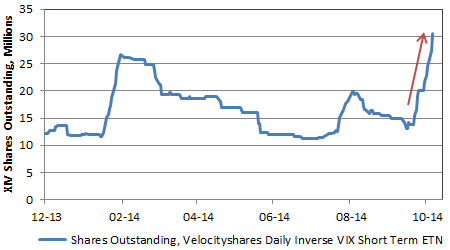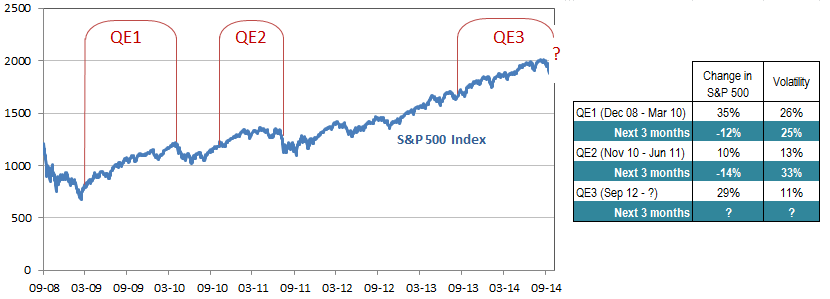By Tim Edwards
Director, Index Investment Strategy
S&P Dow Jones Indices
As you, dear patient reader, have no doubt noticed, volatility is back. The VIX® has reached levels not seen since the peak of the Eurozone crisis over two years ago. The exact reasons might be debatable, but either way October is living up to its perennial reputation as the cruelest month for equities.
Source: CBOE
Each time in recent history that the VIX closed above 20, it has rapidly collapsed (see above). And duly following the principle of induction, spikes in volatility are now interpreted as a selling opportunity (in respect of the VIX) by the average punter. One example of this demand: the largest exchange-traded product providing a short exposure to VIX futures has doubled in shares outstanding in the last few days:
Source: Bloomberg, as of Oct 15th
Yet volatility levels are not guaranteed to fall. If the U.S. Federal Reserve’s largess was indeed the primary cause of the suppressed levels of volatility seen in the first three quarters of this year, the seat-belts are off. QE3 is expected to end in the next few weeks; history was not kind to equity investors in the periods immediately following the last two rounds:
Source: S&P Dow Jones Indices
It requires an unusual degree of foresight, bravery or foolishness to take short positions in the VIX; there are, notoriously, considerable stings in the tail. Moreover, it is a bet framed in terms of death or glory: the VIX rarely resides in the low 20s, instead historically it is brief staging post on the way to crisis or back to recovery. And despite the enthusiasm for selling volatility at current levels, losses can escalate very quickly if it continues to spike. At some point, those short investors will capitulate; the risk is then a material short squeeze.
Hypothetically, such a short squeeze would trigger large purchases in volatility futures just as it is already shooting up. A jump from 25 to 35 in such circumstances is not entirely unfeasible. Investors would be wise to mind the gap.
The posts on this blog are opinions, not advice.
© S&P Dow Jones Indices LLC 2013. Indexology® is a trademark of S&P Dow Jones Indices LLC (SPDJI). S&P® is a trademark of Standard & Poor’s Financial Services LLC and Dow Jones® is a trademark of Dow Jones Trademark Holdings LLC, and those marks have been licensed to SPDJI.
This material is reproduced with the prior written consent of SPDJI. For more information on SPDJI, visit http://www.spdji.com






Discussion
No comments yet.